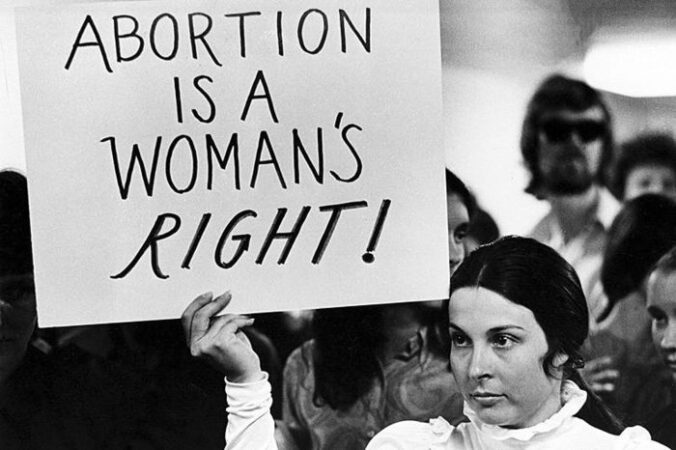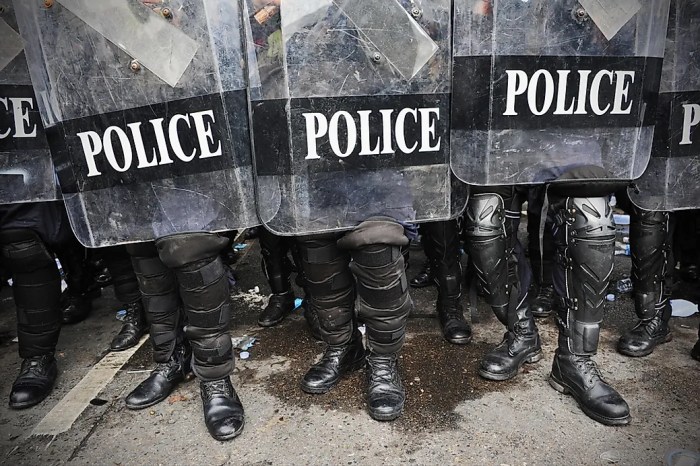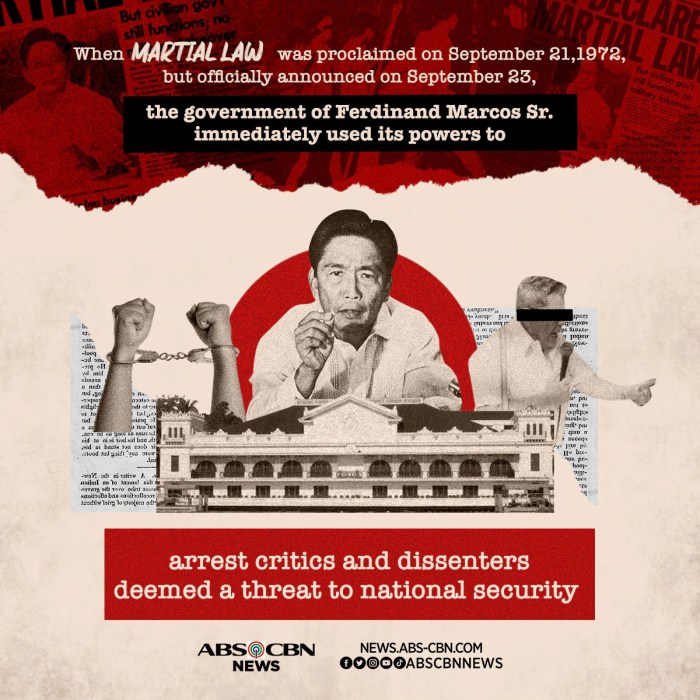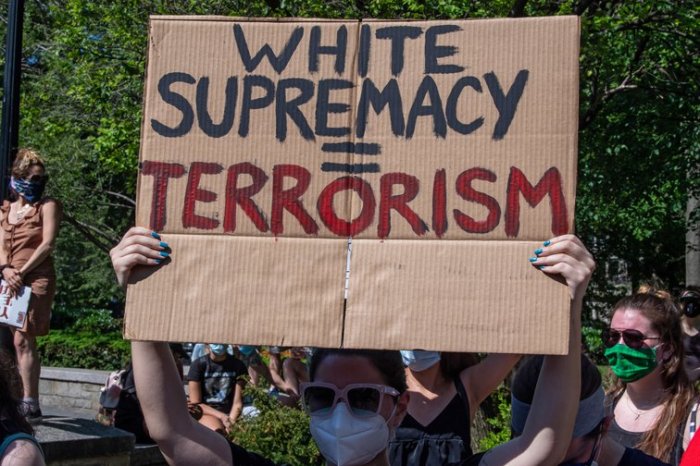
What does martial law mean? It’s a term that often evokes images of military rule and suspended civil liberties, but its implications are far more complex than a simple definition can convey. Martial law represents a temporary suspension of normal legal processes, allowing the military or government to assume extraordinary powers in times of crisis or emergency. Throughout history, martial law has been invoked in various situations, from wartime to natural disasters, each instance leaving its own unique mark on the societies it impacted.
This guide will explore the multifaceted concept of martial law, delving into its historical context, the circumstances that lead to its implementation, and the significant impact it has on society. We will also examine the legal frameworks and procedures surrounding martial law in different countries, highlighting the ethical considerations and human rights implications that accompany its use.
Definition of Martial Law

Martial law is a temporary form of rule where military authorities take control of a region or country, typically in times of emergency or crisis. It overrides the normal civilian legal system and allows the military to enforce laws and maintain order.
Historical Context of Martial Law
The concept of martial law has roots in ancient Roman law, where military commanders were granted special powers during wartime. Throughout history, martial law has been used in various situations, including during revolutions, natural disasters, and times of civil unrest.
Examples of Martial Law Throughout History
- During the American Civil War (1861-1865), President Abraham Lincoln declared martial law in several Confederate states, allowing the Union Army to suppress dissent and enforce military rule.
- In the aftermath of World War II, the Allied powers imposed martial law on Germany and Japan, aiming to dismantle their military capabilities and establish a new order.
- Following the 9/11 attacks, the United States government implemented measures that resembled martial law in certain areas, including the use of military tribunals and increased surveillance.
Circumstances Leading to Martial Law

Martial law is a drastic measure that suspends ordinary law and allows the military to take control of civilian governance. It is a complex and controversial topic, often associated with times of crisis or instability. While the specific circumstances leading to martial law can vary widely, there are common threads that connect these events.
Reasons for Imposing Martial Law
The imposition of martial law is typically justified by the need to address a serious threat to public safety or national security. These threats can stem from various sources, such as natural disasters, civil unrest, or external aggression. The underlying rationale for martial law is to restore order and stability by providing the military with the necessary authority to suppress the threat and protect the population.
Situations Where Martial Law is Typically Declared
Martial law is usually declared in situations where civil authorities are unable or unwilling to maintain order and enforce the law. This can occur during:
- Natural Disasters: In the aftermath of devastating natural disasters, such as earthquakes, hurricanes, or floods, martial law may be imposed to coordinate rescue and relief efforts, maintain order, and prevent looting and other criminal activity. For example, in the wake of Hurricane Katrina in 2005, the governor of Louisiana declared martial law in New Orleans to restore order and facilitate the response to the disaster.
- Civil Unrest: When widespread protests, riots, or civil disobedience threaten public safety and disrupt normal functioning, martial law may be imposed to quell the unrest and restore order. The imposition of martial law in response to civil unrest can be highly controversial, as it can raise concerns about human rights violations and the suppression of dissent. For example, in 1994, the United States imposed martial law in Los Angeles after the Rodney King riots to restore order and prevent further violence.
- External Aggression: In the event of an invasion or other external threat, martial law may be imposed to mobilize the nation’s resources and defense capabilities. This typically involves suspending certain civil liberties, such as freedom of movement and assembly, to facilitate the mobilization of troops and the defense of the nation. During World War II, for instance, the United States imposed martial law in Hawaii after the attack on Pearl Harbor to protect the islands and prepare for the defense of the nation.
- Internal Insurrection: When a rebellion or insurgency threatens to overthrow the government, martial law may be imposed to suppress the uprising and restore stability. In such cases, the military may be tasked with restoring order, disarming rebels, and protecting key infrastructure. The imposition of martial law in response to internal insurrection can be particularly dangerous, as it can escalate the conflict and lead to widespread human rights violations.
Potential Threats or Crises that Necessitate Martial Law
The threats or crises that necessitate martial law are diverse and can evolve over time. Some common examples include:
- Terrorist Attacks: In the wake of a major terrorist attack, martial law may be imposed to enhance security measures, prevent further attacks, and restore public confidence. This could involve increased surveillance, restrictions on movement, and the deployment of military forces to protect critical infrastructure.
- Epidemics or Pandemics: During a public health emergency, such as a pandemic, martial law may be imposed to implement quarantine measures, restrict travel, and ensure the distribution of essential resources. The imposition of martial law in response to a pandemic can be highly controversial, as it raises concerns about individual liberties and the potential for abuse of power.
- Economic Collapse: In the event of a severe economic crisis, martial law may be imposed to maintain order and prevent widespread looting and social unrest. This could involve price controls, rationing, and the deployment of troops to protect essential infrastructure and ensure the distribution of essential goods and services.
Powers and Authorities Under Martial Law
Martial law grants significant powers and authorities to the military or government, allowing them to take control of civilian affairs in exceptional circumstances. These powers are designed to maintain order and security, but they also come with restrictions on civil liberties.
Limitations on Civil Liberties During Martial Law
Under martial law, civil liberties are often curtailed to ensure public safety and maintain order. This may involve restrictions on:
- Freedom of Movement: Curfews may be imposed, and travel restrictions might be implemented to prevent the spread of unrest or control the movement of individuals.
- Freedom of Assembly: Public gatherings and protests may be prohibited to prevent potential disruptions or incitements of violence.
- Freedom of Speech: Censorship may be imposed on media outlets and individuals to prevent the dissemination of information that could be considered harmful or incite violence.
- Freedom of the Press: The media’s ability to report on events may be restricted, and journalists may face censorship or restrictions on their access to information.
- Due Process: The legal system may be altered, with military courts or tribunals taking over some judicial functions. This could lead to faster trials but potentially less due process for individuals.
Comparison of Military Powers Under Martial Law and Normal Times
The powers of the military under martial law differ significantly from those exercised in normal times.
- Expanded Powers: Under martial law, the military has expanded powers to enforce order, including the authority to arrest and detain individuals, impose curfews, control transportation, and regulate communication.
- Limited Civilian Oversight: In normal times, the military operates under civilian oversight and is subject to civilian laws. During martial law, this oversight may be diminished, and the military may have more autonomy in its actions.
- Use of Force: While the military is trained for combat, its use of force is typically restricted in normal times. Under martial law, the military may have broader authority to use force to maintain order and security.
Impact of Martial Law on Society
Martial law, a temporary measure taken in exceptional circumstances, carries significant consequences for society. Its impact reverberates through various aspects of life, affecting the economy, social order, and fundamental human rights. This section examines the potential ramifications of imposing martial law and explores the ethical and legal considerations surrounding this extraordinary measure.
Economic Impact
The imposition of martial law can have a profound impact on the economy. The disruption of normal business operations, the closure of markets and industries, and the imposition of price controls can lead to economic stagnation and even collapse. In extreme cases, martial law can result in widespread unemployment, shortages of essential goods, and a decline in living standards. The economic impact of martial law is often exacerbated by the uncertainty and fear that it generates, discouraging investment and hindering economic growth.
Social Order and Human Rights
Martial law often leads to restrictions on civil liberties and human rights. Curfews, travel restrictions, and limitations on freedom of assembly and speech are commonplace under martial law. These measures, while intended to maintain order and security, can have a chilling effect on freedom of expression and association, and can lead to arbitrary arrests and detentions. Moreover, the concentration of power in the hands of the military during martial law can create a climate of fear and intimidation, eroding public trust and undermining the rule of law.
Ethical Considerations and Legal Implications
The imposition of martial law raises serious ethical and legal concerns. It is a drastic measure that should only be taken as a last resort, when all other options have been exhausted. The ethical justification for martial law lies in its potential to prevent widespread violence, protect public safety, and restore order. However, it is essential to ensure that martial law is imposed in a transparent and accountable manner, and that it is not used as a pretext for suppressing dissent or consolidating power.
“Martial law should be imposed only as a last resort, when all other options have been exhausted.”
The legal implications of martial law are complex and vary depending on the specific legal framework of the country in question. In many countries, martial law is a legal concept, but its scope and limitations are often unclear. It is essential to ensure that any declaration of martial law is consistent with the country’s constitution and international human rights law.
International Perspectives on Martial Law
The concept and application of martial law vary significantly across different countries, reflecting diverse legal systems, historical experiences, and political contexts. This section explores how different nations define and implement martial law, highlighting key differences in their legal frameworks and procedures. It also examines international legal standards and human rights considerations related to the imposition of martial law.
Comparative Legal Frameworks and Procedures
The legal frameworks and procedures for imposing martial law differ considerably among nations. Here’s a table comparing some key aspects of martial law in various countries:
| Country | Legal Basis | Procedures for Imposition | Duration | Powers of Military Authorities |
|---|---|---|---|---|
| United States | No specific constitutional provision, but derived from the inherent powers of the President as Commander-in-Chief. | Presidential proclamation, subject to congressional oversight. | Limited to the duration of the emergency. | Limited to maintaining order and public safety, subject to constitutional constraints. |
| Pakistan | Article 245 of the Constitution allows the President to impose martial law in specific areas. | Proclamation by the President, subject to parliamentary approval. | Indefinite, but subject to parliamentary review. | Broad powers, including the suspension of fundamental rights and the control of civilian administration. |
| India | Article 34 of the Constitution empowers the President to impose martial law in exceptional circumstances. | Presidential proclamation, subject to parliamentary approval. | Limited to the duration of the emergency. | Limited to maintaining order and public safety, subject to judicial oversight. |
| South Africa | No specific constitutional provision for martial law, but the principle of the rule of law is enshrined in the Constitution. | Proclamation by the President, subject to parliamentary approval. | Limited to the duration of the emergency. | Limited to maintaining order and public safety, subject to constitutional constraints. |
International Legal Standards and Human Rights Considerations, What does martial law mean
International law recognizes the right of states to take exceptional measures, including the imposition of martial law, to address grave threats to national security. However, these measures must be proportionate to the threat and comply with international human rights law.
The following principles are fundamental in this regard:
- Necessity: Martial law should only be imposed as a last resort, when other measures are insufficient to address the threat.
- Proportionality: The measures taken under martial law should be proportionate to the threat and should not exceed what is necessary to address it.
- Non-discrimination: Martial law should be applied equally to all individuals, without discrimination on any grounds.
- Human Rights Protection: Even under martial law, fundamental human rights, such as the right to life, liberty, and security of person, should be respected to the greatest extent possible.
“The imposition of martial law should be subject to strict legal controls and should be subject to judicial review.” – International Committee of the Red Cross
Historical Examples of Martial Law

Throughout history, martial law has been implemented in various contexts, ranging from wartime emergencies to political upheavals. Examining these historical instances provides valuable insights into the application, impact, and consequences of this extraordinary legal regime.
Historical Examples of Martial Law
Historical examples of martial law offer a glimpse into the diverse applications and outcomes of this extraordinary legal regime. These instances demonstrate how martial law has been employed in times of war, political unrest, and natural disasters.
- The American Civil War (1861-1865): During the American Civil War, President Abraham Lincoln declared martial law in several Confederate states, including Maryland, Virginia, and Louisiana. This declaration was aimed at suppressing secessionist activities and maintaining Union control over strategic territories. The implementation of martial law led to the suspension of habeas corpus, allowing for the arbitrary detention of individuals suspected of disloyalty. The Supreme Court upheld Lincoln’s actions in the landmark case _Ex parte Milligan_ (1866), ruling that the suspension of habeas corpus was permissible during wartime but should not be extended indefinitely in peacetime.
- British Rule in India (1857-1947): During the Indian Rebellion of 1857, known as the Sepoy Mutiny, the British East India Company imposed martial law across vast regions of India. This declaration was a response to the widespread uprising against British rule, and it allowed for the imposition of strict military control, including the suspension of civilian courts and the establishment of military tribunals. Martial law was instrumental in suppressing the rebellion, but it also led to widespread human rights abuses and contributed to the growing resentment against British rule.
- The Nazi Regime in Germany (1933-1945): The Nazi regime in Germany used martial law as a tool for political repression and the consolidation of its totalitarian power. The Enabling Act of 1933 granted Adolf Hitler dictatorial powers, effectively suspending constitutional guarantees and allowing for the establishment of a police state. The Gestapo, the Nazi secret police, operated with impunity, conducting mass arrests, torture, and executions under the guise of maintaining national security. This example illustrates the potential for martial law to be used for the suppression of political dissent and the establishment of authoritarian rule.
Timeline of Significant Instances of Martial Law
This timeline highlights significant instances of martial law throughout history, demonstrating its recurring use in various contexts.
| Date | Event | Location | Duration |
|---|---|---|---|
| 1861-1865 | American Civil War | Confederate states (Maryland, Virginia, Louisiana, etc.) | 4 years |
| 1857-1859 | Indian Rebellion of 1857 | India | 2 years |
| 1914-1918 | World War I | Various countries (Germany, France, Britain, etc.) | 4 years |
| 1933-1945 | Nazi Regime in Germany | Germany | 12 years |
| 1941-1945 | World War II | Various countries (Germany, Japan, Britain, etc.) | 4 years |
| 1968 | Prague Spring | Czechoslovakia | Several months |
| 1971 | Bangladesh Liberation War | East Pakistan (present-day Bangladesh) | 9 months |
| 1983 | Martial Law in Poland | Poland | 9 months |
| 1987 | Martial Law in the Philippines | Philippines | 9 years |
| 2005 | Hurricane Katrina | New Orleans, Louisiana | Several weeks |
Comparison of Historical Examples of Martial Law
This table compares the duration, causes, and effects of different historical examples of martial law, highlighting the varied circumstances under which it has been implemented.
| Event | Duration | Causes | Effects |
|---|---|---|---|
| American Civil War | 4 years | Secessionist activities, suppression of rebellion | Suspension of habeas corpus, arbitrary detention, suppression of dissent, strengthening of Union control |
| Indian Rebellion of 1857 | 2 years | Widespread uprising against British rule, Sepoy Mutiny | Strict military control, suspension of civilian courts, military tribunals, human rights abuses, resentment against British rule |
| Nazi Regime in Germany | 12 years | Political repression, consolidation of totalitarian power | Suspension of constitutional guarantees, police state, mass arrests, torture, executions, suppression of dissent |
| Hurricane Katrina | Several weeks | Natural disaster, widespread damage, infrastructure collapse | Restoration of order, provision of essential services, coordination of relief efforts, limitations on civil liberties |
Concluding Remarks: What Does Martial Law Mean
Understanding martial law requires a nuanced perspective. It’s not simply a matter of military rule, but a complex system of power and authority with profound implications for individual liberties and societal stability. As we’ve explored, martial law is a potent tool, often employed in times of crisis, but its use should be approached with caution and a deep understanding of its potential consequences. By recognizing the historical precedents, legal frameworks, and ethical considerations surrounding martial law, we can better equip ourselves to navigate these complex situations and advocate for the preservation of human rights, even in times of emergency.
FAQ Summary
What are some examples of martial law being declared in recent history?
Recent examples include the declaration of martial law in the Philippines in 2017 in response to the Marawi siege, and the imposition of martial law in Myanmar following the military coup in 2021.
What are the potential benefits of martial law?
Proponents argue that martial law can be effective in restoring order and security during times of crisis, such as during natural disasters or armed conflicts. It can also provide a framework for rapid decision-making and resource allocation in emergencies.
Can martial law be imposed indefinitely?
No, martial law is typically intended to be a temporary measure. Its duration is often determined by the specific circumstances leading to its declaration and the ongoing need for extraordinary powers.
How can I learn more about martial law in my country?
You can consult your country’s constitution, legal statutes, and relevant government websites to understand the legal framework and procedures surrounding martial law in your jurisdiction.




